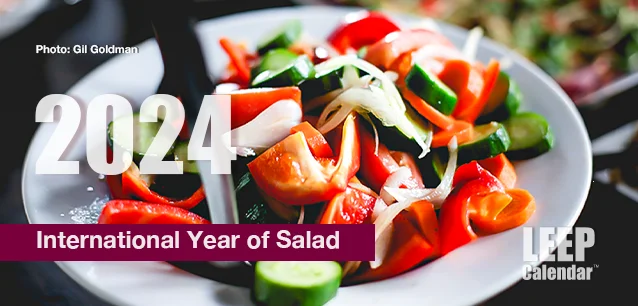 AD
AD
Today is: December 08
Scroll to explore events active on this date.
Additional Events on LEEP
LEEP INK FEATURES

August? Absolutely!
In August, we live through the Dog Days of Summer. It's hot and often humid, and those who can leave for better climates do. Down south, winter is in full force. August is also known as "the ...

In The Heat of July: July 2025 Events
Is it hot enough (or cold enough if you're below the equator) for you yet? There is actually a day for that! Like every month, I pick a diverse collection of events you may or may not know about. This ...

May Blooms: Events in May 2025
Along with October, May is one of the most densely packed months of the year. It's before the summer humidity and the last whole month of the school year. The weather is warming in t...
About the International Year of Salad
Health , Retail
Ends: Dec 31, 2024
DESCRIPTION:
Each year one flower and one vegetable are chosen for focus by the Fleuroselect Home Garden Association. 2024 is the International Year of Salad.
Salad, a dish consisting of a mixture of small pieces of food, usually featuring vegetables, has a history that spans many centuries and cultures. Ancient Romans and Greeks ate mixed greens with salt, oil, and vinegar dressings. The word "salad" comes from the Latin "sal" (salt), which was a main ingredient in the dressings. By the Middle Ages in medieval Europe, salads evolved to include raw, cooked, and preserved vegetables mixed with various meats and fish. Salads were often served as a starting course to aid digestion.
During the Renaissance, salads became more elaborate, and chefs experimented with various herbs, flowers, and other ingredients. Advanced chefs designed salads to be visually appealing works of art.
As the world expanded through exploration and colonization in the 17th and 18th centuries, salads reflected the optimism in Europe. The French were particularly influential in refining salad dressings and compositions through courses; now, salads were usually served before the dessert.
With the industrial revolution of the 19th century and advances in health and nutrition, salads were considered healthy meals. The introduction of new vegetables from the Americas and the influence of different international cuisines contributed to the diversification of salad recipes.
By the 20th century, salads became a staple in Western diets and standardized through new recipes like the Cesar Salad, Jell-o salads, three bean salad, and Chinese Chicken Salad. In the 1970s, Salad bars began to appear in restaurants, allowing diners to customize their salads with various ingredients.
With the growing awareness of healthy eating and the emphasis on fresh, local, and organic produce, salads have continued to evolve. They can range from simple side dishes to full, gourmet meals with influences from various global cultures.
Salads can be hot or cold in modern cuisine and include virtually any combination of ingredients, from vegetables, fruits, nuts, grains, meat, or fish. Dressings and seasonings have also become more varied, with chefs continually experimenting with flavors and textures. Salads are a testament to human creativity in using available resources to create nourishing and appealing food.
VIDEOS
SUPPORTING DOCUMENTS
Currently, this event does not have supporting documents.
ADDITIONAL IMAGES
Currently, this event does not have supporting images.
Where would you like to go now?
 AD
AD


/footer-logo.svg)
